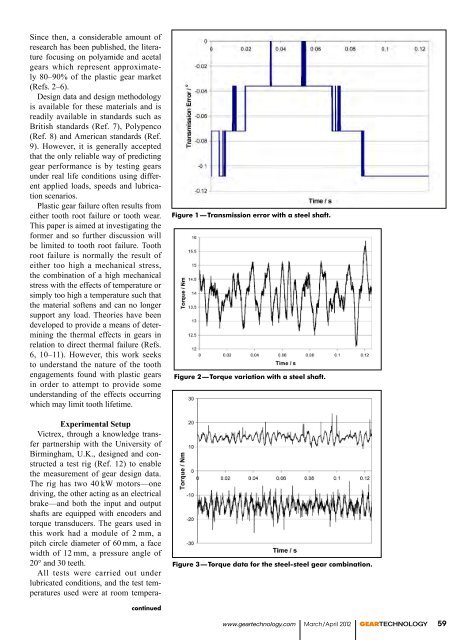Download PDF - Gear Technology magazine
Download PDF - Gear Technology magazine
Download PDF - Gear Technology magazine
Create successful ePaper yourself
Turn your PDF publications into a flip-book with our unique Google optimized e-Paper software.
Since then, a considerable amount of<br />
research has been published, the literature<br />
focusing on polyamide and acetal<br />
gears which represent approximately<br />
80–90% of the plastic gear market<br />
(Refs. 2–6).<br />
Design data and design methodology<br />
is available for these materials and is<br />
readily available in standards such as<br />
British standards (Ref. 7), Polypenco<br />
(Ref. 8) and American standards (Ref.<br />
9). However, it is generally accepted<br />
that the only reliable way of predicting<br />
gear performance is by testing gears<br />
under real life conditions using different<br />
applied loads, speeds and lubrication<br />
scenarios.<br />
Plastic gear failure often results from<br />
either tooth root failure or tooth wear.<br />
This paper is aimed at investigating the<br />
former and so further discussion will<br />
be limited to tooth root failure. Tooth<br />
root failure is normally the result of<br />
either too high a mechanical stress,<br />
the combination of a high mechanical<br />
stress with the effects of temperature or<br />
simply too high a temperature such that<br />
the material softens and can no longer<br />
support any load. Theories have been<br />
developed to provide a means of determining<br />
the thermal effects in gears in<br />
relation to direct thermal failure (Refs.<br />
6, 10–11). However, this work seeks<br />
to understand the nature of the tooth<br />
engagements found with plastic gears<br />
in order to attempt to provide some<br />
understanding of the effects occurring<br />
which may limit tooth lifetime.<br />
Experimental Setup<br />
Victrex, through a knowledge transfer<br />
partnership with the University of<br />
Birmingham, U.K., designed and constructed<br />
a test rig (Ref. 12) to enable<br />
the measurement of gear design data.<br />
The rig has two 40 kW motors—one<br />
driving, the other acting as an electrical<br />
brake—and both the input and output<br />
shafts are equipped with encoders and<br />
torque transducers. The gears used in<br />
this work had a module of 2 mm, a<br />
pitch circle diameter of 60 mm, a face<br />
width of 12 mm, a pressure angle of<br />
20° and 30 teeth.<br />
All tests were carried out under<br />
lubricated conditions, and the test temperatures<br />
used were at room tempera-<br />
Figure 1 — Transmission error with a steel shaft.<br />
Figure 2 — Torque variation with a steel shaft.<br />
Figure 3 — Torque data for the steel-steel gear combination.<br />
continued<br />
www.geartechnology.com March/April 2012 GEARTECHNOLOGY 59
















